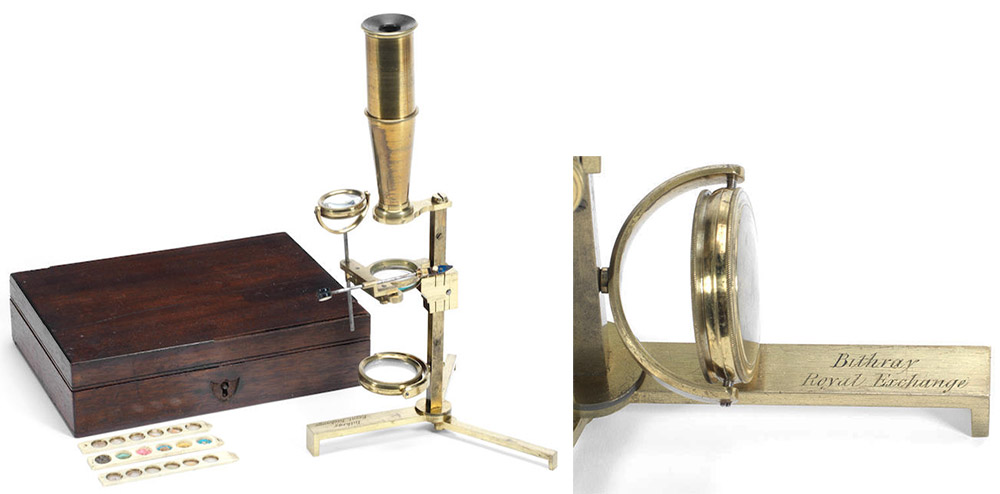
Figure 1. A compound/simple microscope with folding tripod base, signed “Bithray, Royal Exchange”. Adapted for nonprofit, educational purposes from an internet auction site.
Stephen Bithray, ca. 1789 - 1858
by Brian Stevenson
last updated August, 2021
Stephen Bithray produced and sold optical and scientific/engineering instruments from 1826 until his death in 1858. A variety of microscopes are known that bear Bithray’s name (Figures 1-4). The bodies of his microscopes resemble those of many other makers of the era, suggesting that many might have been acquired from wholesale brass workers. However, Bithray was a skilled glassworker, and probably manufactured all of the lenses in-house.
For most of his career, Bithray’s shop was located in the Royal Exchange, London. That complex burned down on January 10, 1838; for the following 6 years, Bithray operated from the nearby Spread Eagle Court, then moved into the new Royal Exchange when it opened in 1844 (see Figures 5-7). Before the fire, his address was often given as “4 North Piazza (or “Gate”), Royal Exchange”, while after the fire his address was “29 Royal Exchange”. Some of Bithray’s instruments are engraved with those details (e.g. Figure 11), but most carry a simple “Royal Exchange”, leaving uncertainty as to their dates of manufacture.
Another man named Bithray briefly made and sold optical and scientific instruments in London. William Bithray (1816-1855) was a nephew of Stephen’s and had been his apprentice (Figure 16). William then worked for many years with Thomas Rubergall (1775-1854). Following Rubergall’s death, William Bithray partnered with another of Rubergall’s employees, Thomas Steane, as “Bithray and Steane” (Figure 17). That business lasted for only a short time, and few items are known to bear their names.

Figure 1.
A compound/simple microscope with folding tripod base, signed “Bithray, Royal Exchange”. Adapted for nonprofit, educational purposes from an internet auction site.
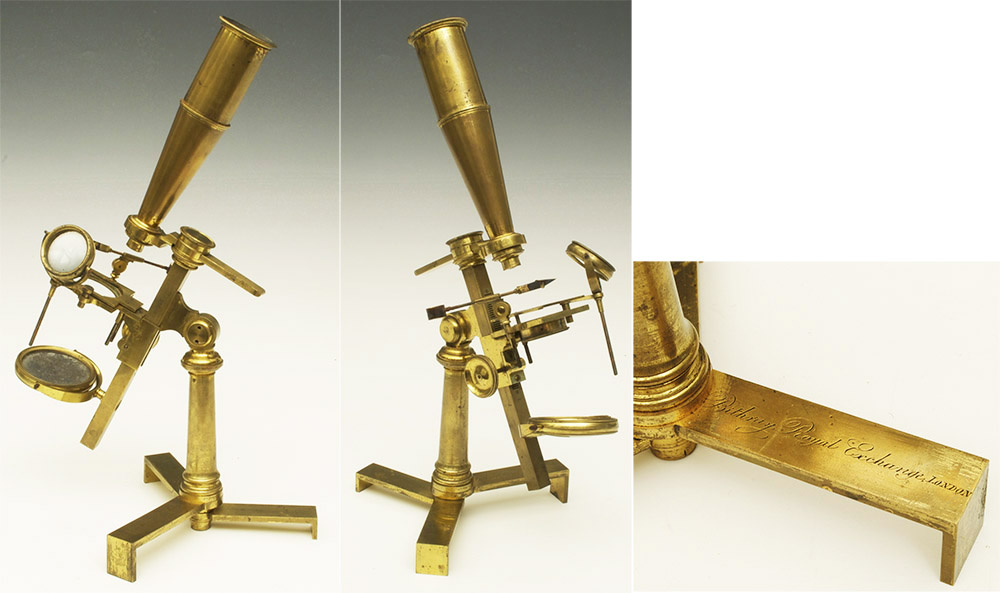
Figure 2.
A variation on the “Jones’ Most Improved” microscope, signed “Bithray, Royal Exchange, London”. The Golub Collection holds another of this Bithray model, http://golubcollection.berkeley.edu/19th/93.html. Adapted for nonprofit, educational purposes from an internet auction site.
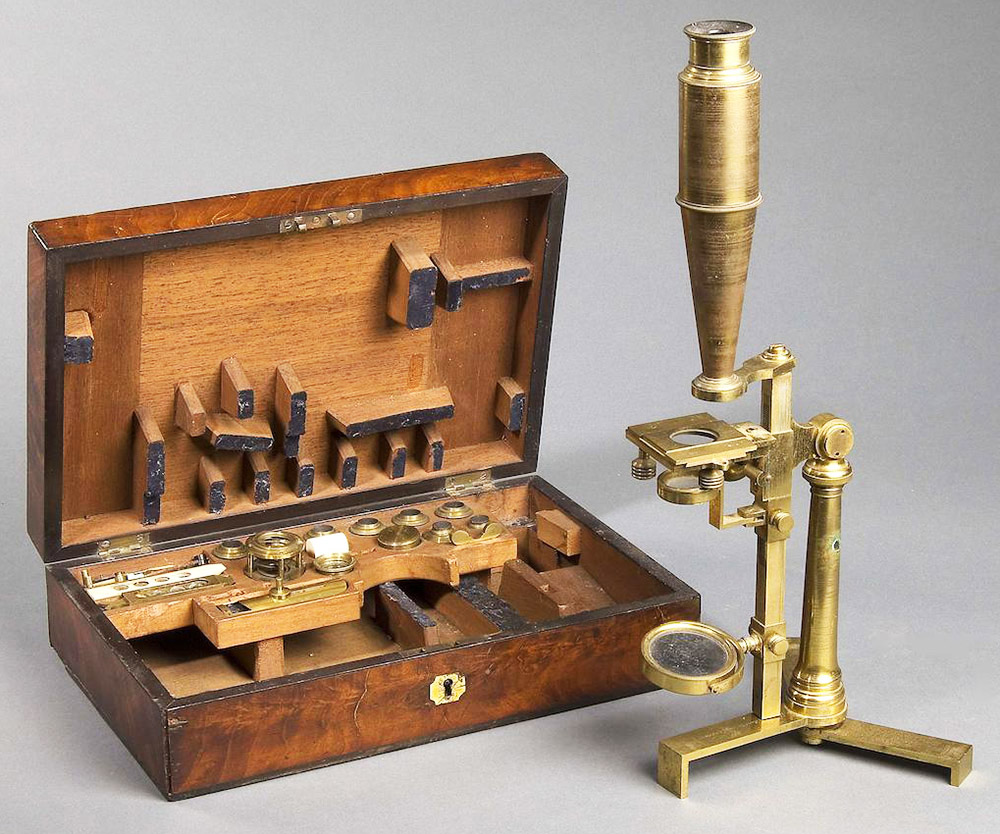
Figure 3.
Another variation on the “Jones’ Most Improved” design, signed “Bithray, Royal Exchange, London”. Adapted for nonprofit, educational purposes from an internet auction site.

Figure 4.
A “Culpeper”-type compound microscope, signed “Bithray, Royal Exchange, London”. Adapted for nonprofit, educational purposes from an internet auction site.

Figure 5.
The Royal Exchange, prior to the fire of 1838. Stephen Bithray’s shop was located near the North Gate, on the far side of the courtyard in this illustration. From “Wilson’s Description of the New Royal Exchange”.
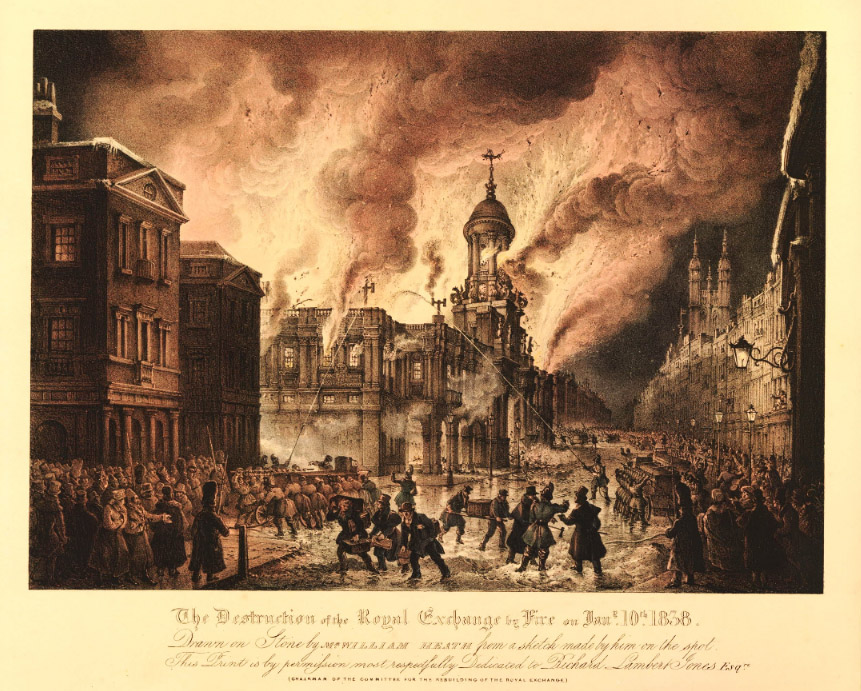
Figure 6.
The Royal exchange was destroyed by fire on January 10, 1838. Adapted for nonprofit, educational purposes from an image of the British Museum.

Figure 7.
After the fire of 1838, Stephen Bithray relocated to nearby 6 Spread Eagle Court, remaining until the new Royal Exchange opened in 1844. Adapted for nonprofit, educational purposes from an engraving in possession of the City of London.
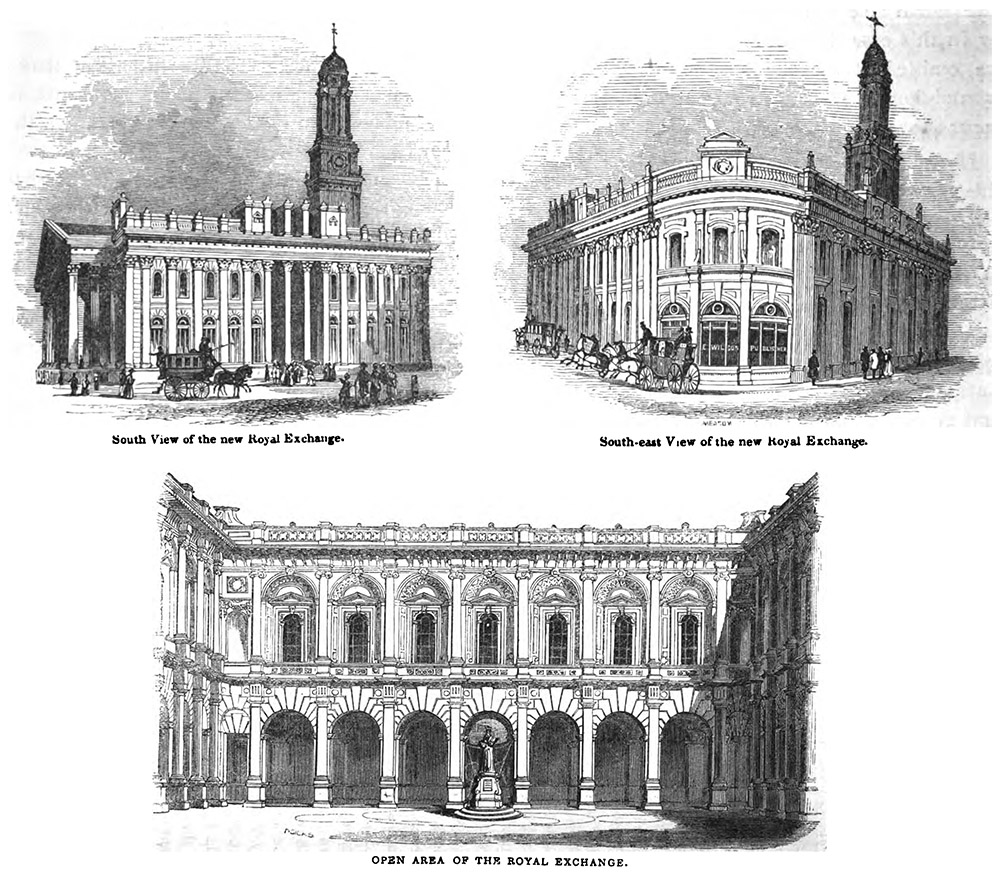
Figure 8.
The new Royal Exchange, which opened in 1844. Stephen Bithray occupied the space designated as number 29, near the north entrance. Illustrations from “Wilson’s Description of the New Royal Exchange”.
Stephen Bithray reported to census-takers that he was born in the Shoreditch area of London, and provided his age as having been born in about 1789. His guild membership records state that his father’s name was also Stephen (Figure 9).
Little is known of Bithray’s early life. He married Mary Hannah Docksey on August 2, 1812. The marriage was witnessed by “Jos Smith”, presumably the Joseph Smith (1766-1825) whose optical business was acquired by Bithray in 1826. Of note, Smith’s widow lived with one Elizabeth Doxsey after his death. Altogether, these bits of information suggest that Stephen Bithray was working for Joseph Smith in 1812. Smith operated a shop in the Royal Exchange complex, being number 4 near the North Gate. He had acquired that space in 1811, following the death of optician and microscope-maker James Long (ca. 1755 - 1811).
Some instruments are known that are signed "Bithray successor to J. Smith, Royal Exchange, London". Joseph Smith died in December, 1825, and his will was probated in February, 1826. Bithray probably purchased Smith’s stock shortly after that date, and took up the lease at Royal Exchange.
Consistent with the above, Stephen Bithray joined the Wheelwright’s guild in 1826 (Figure 6). At that time, a guild’s name need not correspond with its members’ occupations. The reason for Bithray’s choice of that guild is not known. Guild membership gave Bithray the right to take apprentices, which included his nephew William Bithray (Figure 16).
Stephen’s wife, Mary Hannah, died in May, 1833. I did not find records of them having had children. Bithray remarried on March 26, 1835, to Elizabeth Goodrick. They had at least 5 children together. The 1841 and 1851 national censuses indicate that the Bithray’s were fairly well-off, living in houses away from Stephen’s shop, and employing house servants.
The Royal Exchange burned down on January 10, 1838. As a result, Bithray opened a new shop nearby, at 6 Spread Eagle Court. The 1843 Post Office Directory of London shows that Bithray was still in Spread Eagle Court at the time of publication. The new Royal Exchange opened in 1844, and Bithray was one of the first occupants, taking a space designated as number 29. Some of his instruments show that number, but most give only “Royal Exchange” as an address, which would be adequate since he was the only Bithray in the building. The new shop was in the same relative location as the old one, near the north entrance to the Royal Exchange (Figures 8 and 10).
Stephen Bithray died on February 9, 1858, at his home at 4 St. John’s Terrace. Newspaper advertisements indicate that he was still in business at the time of his death.
Bithray’s shop in the Royal Exchange was taken over by Henry Macrae (1807-1889). Macrae manufactured microscopes and other optical and scientific apparatus. He had established a shop at 34 Aldgate ca. 1840. Macrae retained his old shop (which was also his home) after acquiring Bithray’s space, and his subsequent products were marked with both addresses.
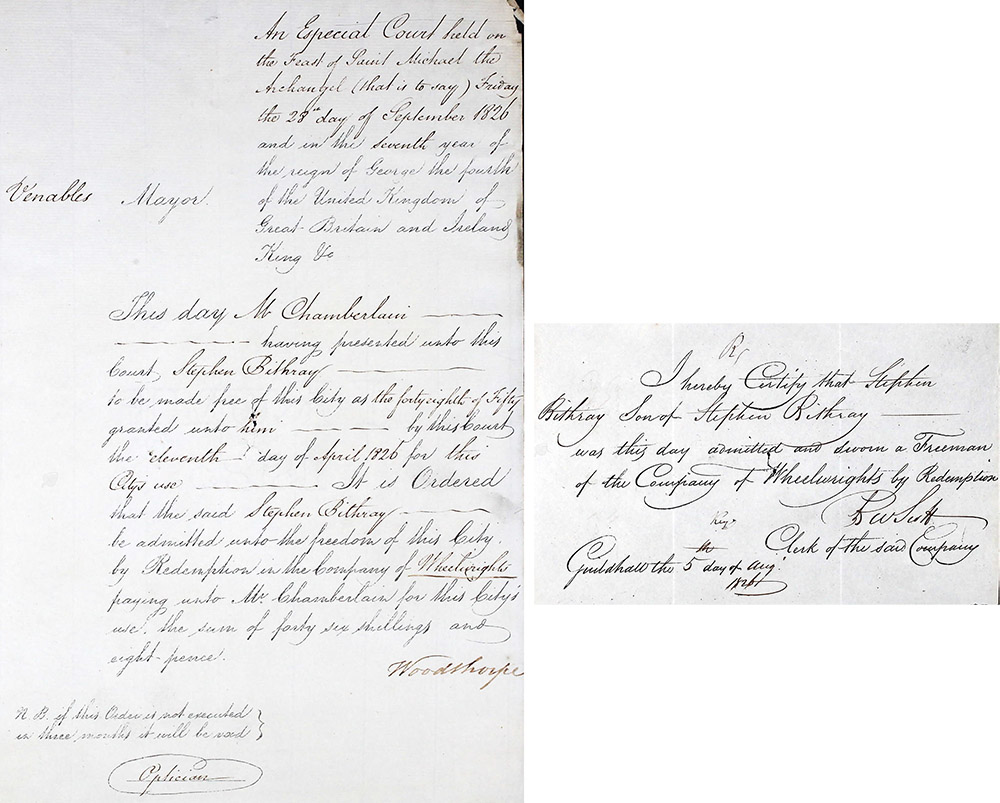
Figure 9.
Records of Stephen Bithray’s 1826 admission into the Worshipful Company of Wheelwrights. At that time, the name of a guild did not necessarily reflect the occupation of its members. Note the first page’s note that Bithray was an “optician”. The reason for Bithray joining this particular guild is not known - it is possible that his apprenticeship master was a member of the Wheelwrights, or that he was friends with a member who sponsored his membership. Bithray joined by “redemption”, paying 46 shillings and 8 pence for the privilege of membership. That he did not join by virtue of patrimony indicates that Bithray’s father was not a member of this guild. Stephen’s nephew, William Bithray, became a member of the Wheelwrights after serving an apprenticeship with Stephen (see Figure 18). William’s son, Ebenezer, joined by virtue of patrimony.
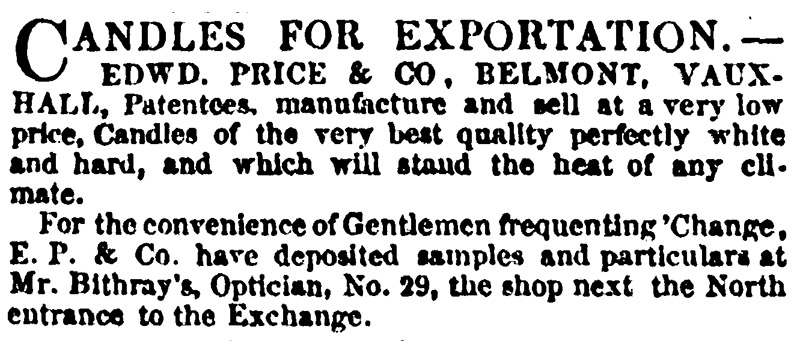
Figure 10.
An 1846 advertisement, indicating that Stephen Bithray’s shop was located near the north entrance to the Royal Exchange.

Figure 11.
A telescope by Stephen Bithray. Adapted for nonprofit, educational purposes from an internet auction site.

Figure 12.
A pocket-sized monocular opera glass by Bithray. Adapted for nonprofit, educational purposes from an internet auction site.
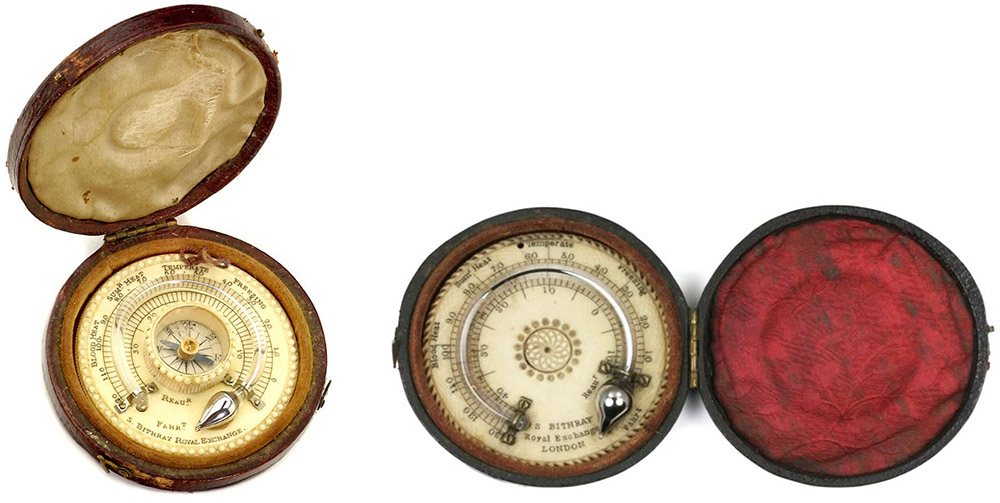
Figure 13.
Two pocket-sized, travel thermometers. Opticians of the time were skilled in glass working, and Bithray likely produced the thermometer tubes. Adapted for nonprofit, educational purposes from internet auction sites.
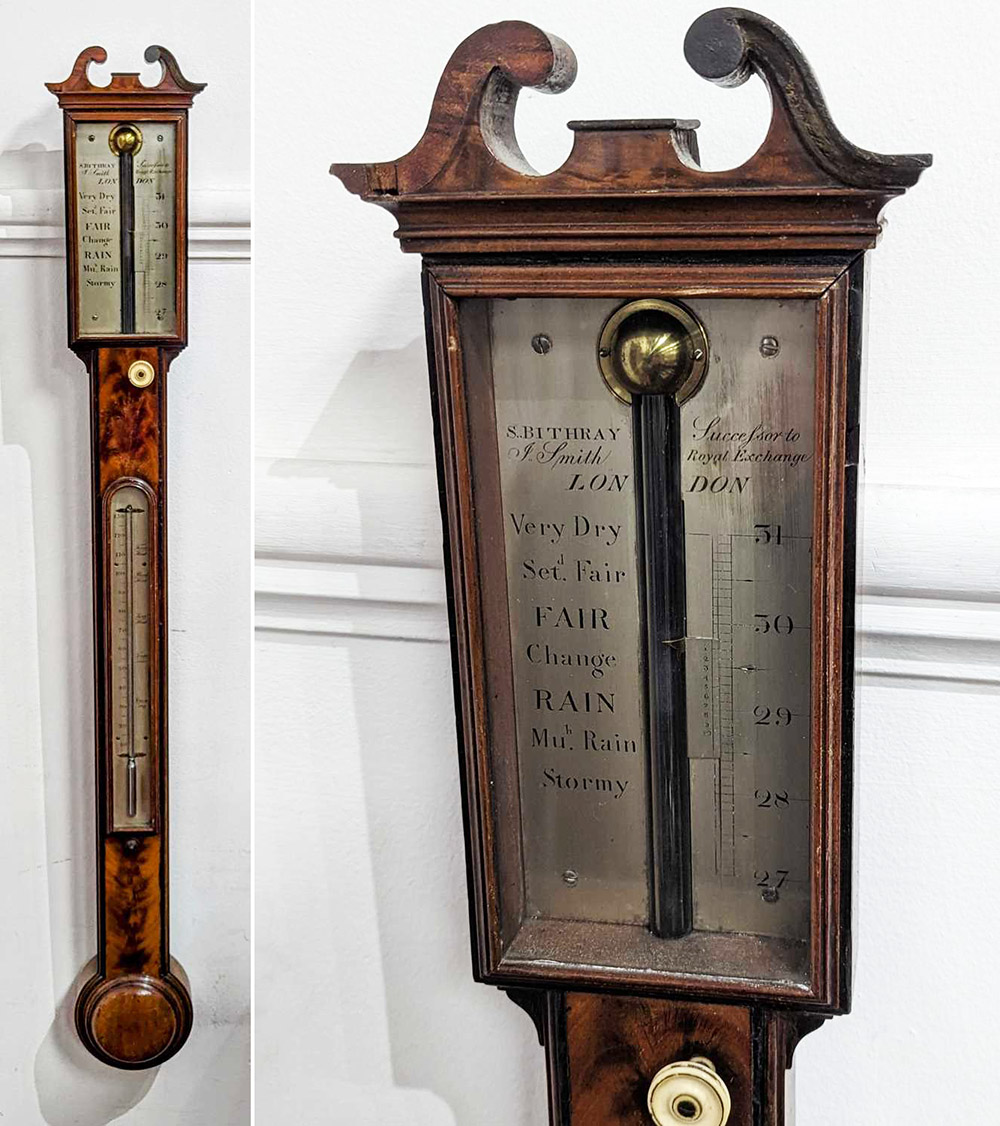
Figure 14A.
Barometer, signed "S. Bithray, successor to J. Smith, Royal Exchange, London". Adapted for nonprofit, educational purposes from an internet auction site.
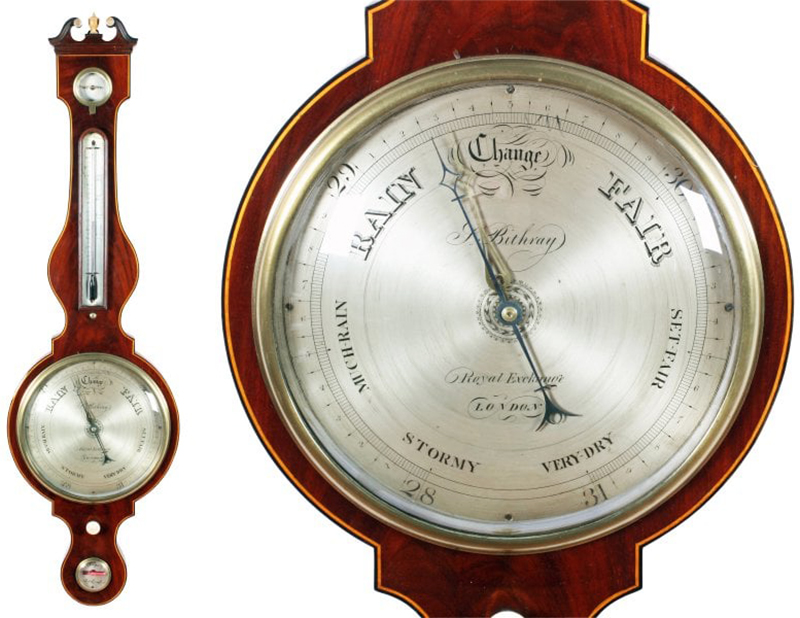
Figure 14B.
A wall-mounted barometer and thermometer by Stephen Bithray. Adapted for nonprofit, educational purposes from an internet auction site.
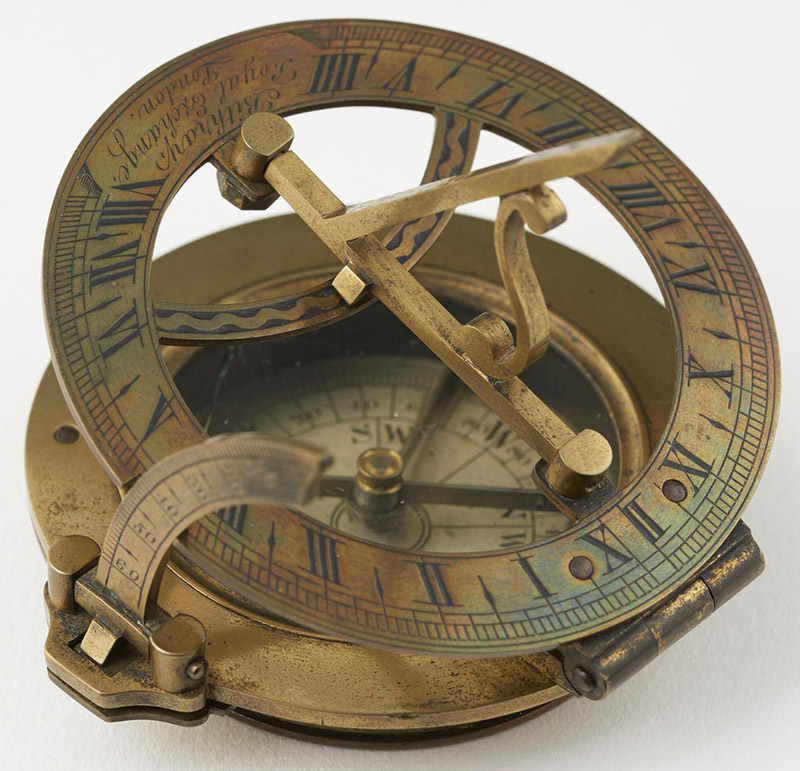
Figure 15.
A compass sundial by Stephen Bithray. Adapted for nonprofit, educational purposes from https://collection.sciencemuseumgroup.org.uk/objects/co685/universal-compass-and-sundial-in-brass-compass-sundial.
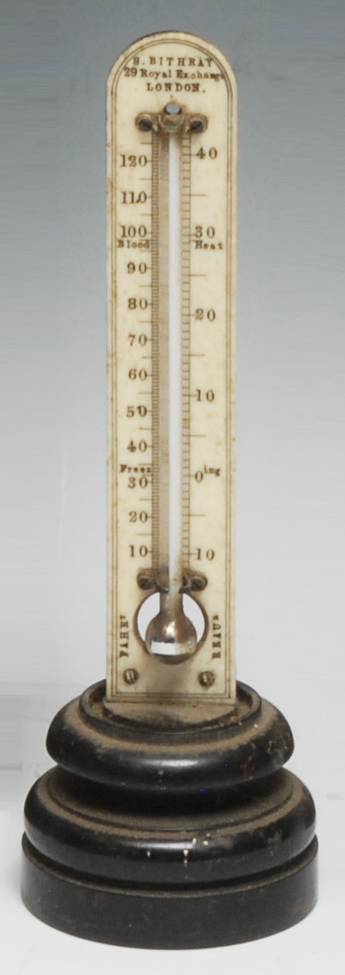
Figure 16.
Thermometer by Stephen Bithray, made of ivory and ebony. Adapted for nonprofit, educational purposes from an internet auction site.

Figure 17.
The 1831 document that bound Stephen Bithray’s nephew, William, to a seven-year apprenticeship. At the time of indenture, the sheet included two identical copies. These were then separated by an irregular cut, and the lower copy retained by the Guildhall. The wavy cut ensured against fraud, since both copies could be compared by aligning the cut edge.

Figure 18.
Trade card of the partnership between William Bithray and Thomas Steane. Both had been employees of scientific instrument-maker Thomas Rubergall (1775-1854), and succeeded to his business after Rubergall’s death. The new business did not last for long, as William Bithray apparently died in 1855. Adapted for nonprofit, educational purposes from an image made available by The British Museum.
Resources
Apprenticeship record of William Bithray (1830) accessed through ancestry.com
Christening record of William Bithray (1816) Parish records of Saint Mary Islington, accessed through ancestry.com
cityoflondon.gov.uk (accessed February, 2020) “Plan of fire in Cornhill, November 10th, 1759. Showing Cornhill, Threadneedle Street, Royal Exchange, Finch Lane, Newmans Court, Spread Eagle Court, Sweetings Alley, and Sweetings Rents” dated 1759, engraver unknown, https://collage.cityoflondon.gov.uk/view-item?i=1571&WINID=1581388189936
“Curiosmith” (accessed February, 2020) Elizabeth Catlett, https://curiosmith.com/pages/elizabeth-catlett
Death record of Mary Hannah Bithray (1833) accessed through ancestry.com
The Economist (1846) Advertisement for Price & Co. candles, Vol. 4, page 560
England census and other records, accessed through ancestry.com
Evening Star (1858) Advertisement from Stephen Bithray, April 3 issue
Freedom of the City records of Stephen Bithray (1826) accessed through ancestry.com
Freedom of the City records of Ebenezer Bithray (1878) accessed through ancestry.com
The Lancet (1855) Advertisements from Bithray and Steane
London Electoral Register (1837) “Bithray, Stephen - shop - North side of the Exchange”, accessed through ancestry.com
Marriage record of Stephen Bithray and Mary Hannah Docksey (1812) Parish records of Saint Luke Old Street, accessed through ancestry.com
Marriage record of Stephen Bithray and Elizabeth Goodrick (1835) Parish records of Saint Leonard’s Shoreditch, accessed through ancestry.com
Post Office Directory of London (1807) “Long James, Optician, Royal Exchange”, page 170
Post Office Directory of London (1812) “Smith Joseph, Optician, Royal Exchange, North Gate”, page 286
Post Office Directory of London (1825) “Smith Joseph, Optician, Royal Exchange North Gate”, page 373
Post Office Directory of London (1829) “Bithray Stephen, Optician, North gate, Royal Exchange”
Post Office Directory of London (1843) “Bithray Stephen, Optician, 6 Spread Eagle court, Cornhill”
Post Office Directory of London (1845) “Bithray Stephen, optician, 29 Royal Exchange”
Post Office Directory of London (1856) “Opticians … Bithray & Steane, 24 Coventry st., Haymkt …Bithray Stephen, 29 Royal Exchange … Macrae Henry, 34 Aldgate”, page 1874
Post Office Directory of London (1865) “Macrae Henry, optician & mathematical instrument maker, 34 Aldgate E, & 29 Royal Exchange EC”, page 1196
Probate of the Will of Stephen Bithray (1858) “The will of Stephen Bithray late of the Royal Exchange in the City of London and of St. John’s-terrace in the County of Middlesex Optician deceased who died 9 February 1858 at 4 St. John’s-terrace aforesaid was proved at the Principal Registry by the oath of Elizabeth Bithray of 4 St. John’s-terrace aforesaid Widow the Relict and the sole Executrix. Effects under £300”, accessed through ancestry.com
Robson’s London Directory (1840) “Spread Eagle ct. … 6 Bithray S, optician”
Saunders, Ann (1997) The Royal Exchange, London Topographical Society, page 236
Will of Sarah Bithray (1840) Stephen’s sister, names him as her brother, accessed through ancestry.com
Wilson, Effingham (1844) Wilson's Description of the New Royal Exchange, E. Wilson, London